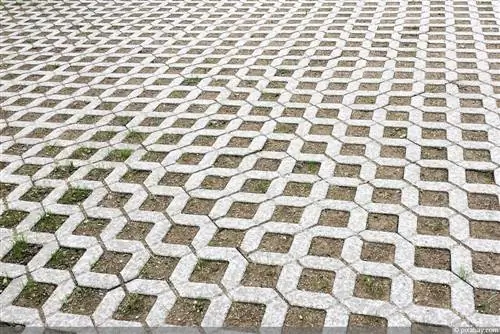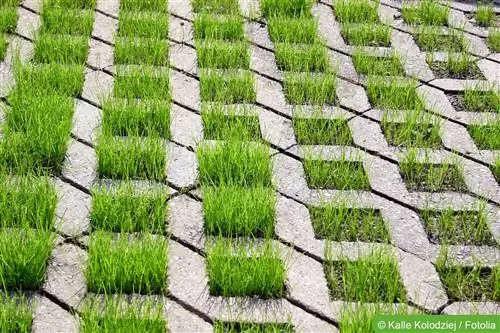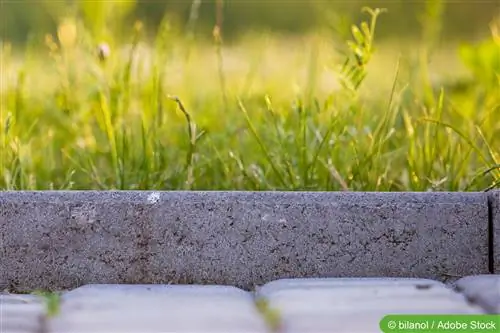- Author admin [email protected].
- Public 2023-12-17 03:39.
- Last modified 2025-01-24 12:45.
Lawn edge stones can be placed in sand or concrete. It is also possible to lay it directly into the ground. However, if you want to prevent the stones from slipping over time, it is best to place them on a concrete foundation. This prevents the stones from sinking in the long term. Don't worry, this work can also be done easily by an energetic layperson. Below is the theoretical foundation, from choosing the right stones to mixing the right mixture.
Concrete, sand or earth
A stable installation of the lawn edge stones in concrete is recommended
- if there is a large margin between the areas to be delimited
- if the soil is particularly loose
- if subsidence and other irregularities are to be prevented over time
- on slopes and if the boundary is also intended to serve as protection against washing out
- for particularly large areas
- If they lead directly along a paved path or a garage driveway
Stones, costs
Stones made of concrete or granite are best suited for laying in concrete. Here everyone can decide according to their taste and budget. You have to expect costs of two to seven euros for the running meter of concrete blocks. It entirely depends on the quality and thickness of the stones. You can spend 10 to 30 euros on granite stones per meter. The larger the purchase quantity, the better the price offer will be.
Selection, purchase
Before you start making your selection, the course of the lawn edge must be clear. Should there only be a straight border on one side, should the corners of the borders be square or rounded? You get a beautiful harmony with a curved border. It looks nice, but can be problematic when mowing the lawn. It is also possible to sink the stones at ground level so that the mower can drive over them. As a rule, however, they end with the tip of the blades of grass. So, before visiting the hardware store, determine the number of meters required and note the number of corner stones and the curves. A little decision-making aid:
- Narrow stones are not suitable for a large difference in level between the adjacent sides. They lean slightly to the side.
- Smaller stones look nicer for demarcating bed sections.
- For curved lines, suitable stones must be chosen for curves.
- Large and robust stones should be chosen if they are to lead along a driveway or a heavily used path.
Material
As before preparing an elaborate menu, it is also helpful when laying stones to have all the “ingredients” ready beforehand:
- Lawn edge stones
- Cut-off machine
- Sand, coarse and fine gravel
- Cement
- Water
- Spade
- string, scissors
- rubber hammer
- Mason's Trowel
- tub, bucket
- Meter measure, spirit level
Preparation
First, use a spade to cut a vertical edge along the border of the lawn. If straight lawn edges are planned, it makes sense to mark the route with a string beforehand. A trench is now dug along this edge. The size depends entirely on the stones. After completing the work, the stones should protrude about four to five cm from the ground. For the standard stone size, a depth of approximately 70 cm will be required, with a width of approximately 50 cm.
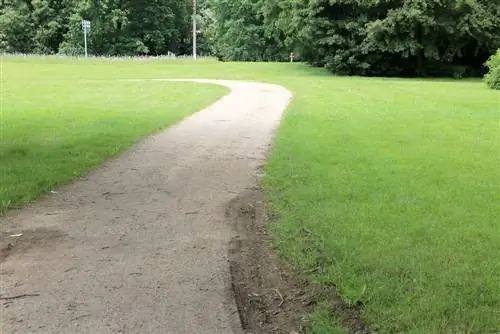
This trench is filled with coarse gravel about 10 cm high. The gravel must be carefully compacted (compacted). For the next layer, mix sand with fine gravel and spread this mixture another 10 cm high on the first layer of gravel. Now it's time to carefully compact again.
Concrete
Lean concrete is usually used for the foundation of lawn curbs. Lean concrete is earth-moist and has a lower cement content than normal concrete. It is usually used for laying curbs. For this purpose, you can easily make the required amount yourself. Either in a concrete mixer or in a square mortar tub. The usual and sufficient mixing ratio is five parts gravel (grain size 0.8 mm) to one part cement. A quantity of water cannot be generally predicted. Roughly speaking, one kilogram of cement is half a liter of water.
First the cement is mixed with the water to form a kind of glue, then the aggregate (gravel, sand) is added. It is better to start with less water at the beginning and add more water at the end if necessary. It is not possible to say exactly how much water is needed. This also depends on the outside temperature, the humidity and the moisture of the aggregate. For smaller concreting jobs, you're on the safe side with half a liter of water per kilogram of cement.
Tip:
The amount of lean concrete or cement required depends on the respective volume. So length times width times height. Delivering the concrete might not be worth it for this type of project. If you mix it yourself, you are more independent over time.
Embarrassed
The earth-moist concrete can now be applied to the compacted gravel layer. Not too much, so that the stones don't end up sticking out too high; they should be about five centimeters above the turf. The concrete must be thoroughly trodden again before the first stone is placed. This must be aligned carefully and ideally with a spirit level. Now you can stretch a string again to adjust the height of all the other stones.
Tip:
During the entire concrete work, the area must be protected from heavy rain until the concrete has hardened. Otherwise the cement components will be washed out and the construction will lose stability.
The stones are placed on the concrete and brought to the correct height using a rubber mallet. A spirit level is useful for this. Once all the lawn edging stones have been laid, you can give them even more stability by using a trowel to spread some concrete on the sides, right and left, as a wedge-shaped support. Finally, three quarters of the stones should be embedded in concrete. Now let the concrete harden for a day. Once the concrete has hardened, you can fill the trench with earth again.
Tip:
There should be a small gap between the stones, this protects the stones from brittle spots on the edges.
The luxury version
If you want to be very comfortable when mowing the lawn, you can lay a row of flat paving stones next to the lawn edge stones. This keeps the lawn away from the curbs and allows you to easily drive one wheel of the mower along it. There is no need to recut the lawn curbs.
Beautiful shapes
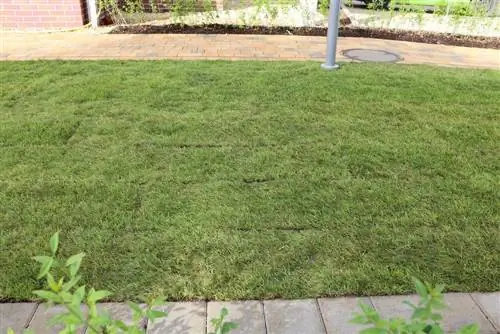
In some gardens, a curved lawn edge fits the picture better than a simple straight line. For example, lawn edging stones that have a curve (convex, concave) on both sides are suitable for this. Of course, the string as a guideline has had its day. Here you can easily mark the lines for excavation with a garden hose. For larger projects, it is advisable to lay out the stones in the grass with the desired curves. Don't be surprised, it will take some time until the curved lines create a harmonious whole. Then you can pierce the stones on the right and left with the spade. The stones are then put away and you can start excavating.
Slope location
The lawn stones can be used in a cascade shape on a slope or with a steep gradient. Since the ground exerts a lot of pressure on the stones, setting them in concrete is definitely recommended.
Conclusion
That doesn't sound that difficult, does it? If you choose the stable option with the lawn edging stones set in concrete, you are definitely on the safe side. If the stones are only intended to separate a flower bed from the lawn, it is sufficient to spread some mortar or lean concrete on the right and left in a wedge shape on the stones in the gravel bed.




